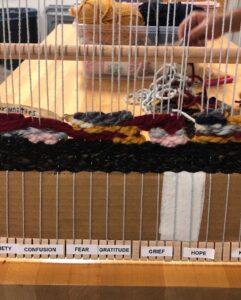Placemats is a collaborative weaving project to produce data visualizations. Using the HASTAC blog and social media, we will collect submissions of keywords in advance of the conference that signify points of connection, shared experiences, or commonalities during the ongoing COVID-19 pandemic. These keywords form the foundation (by labeling the warp strands) of each woven piece. The body of the fabric (the weft) is created collaboratively at the event as conference participants weave into the areas that speak to them (fig. 1), connecting their own experience of COVID to that of others and creating a tactile visualization of the “quantified self-in-kinship” (Knight). The resultant data visualizations are characterized by uneven textures, gaps, and other irregularities. On one hand, these defy the norms of proper weaving practice; on the other, the tactile and visual experience of the finished visualizations aligns with the sense that we have experienced (are indeed still experiencing) collective trauma. The material forms of the visualizations echo Andres Ramirez Gaviria’s framing of artistic data visualizations that are not trying to efficiently convey information but instead explore questions or issues in a way not possible via other means (482).
By crowdsourcing emotions and experiences and weaving collectively in community at the conference, Placemats draws upon multiple of D’Ignazio and Klein’s principles for feminist data visualization, specifically their call to “consider context,” “legitimize embodiment and affect,” and “make labor visible” (3-4). The visualizations produced are small in scale, akin to a placemat, and the aesthetics and contours of each placemat is specific to the particular time and place of its creation.

The placemat, as a feature of the kitchen table, reminds us of the many ways in which the boundaries of our homes took on different meanings during the pandemic. In regard to previous projects, we have argued that “the kitchen table has long held a place in the public imagination as a site of nourishment, family gathering, and care, but it also has served as an important hub of political organizing and movement-building. As a space of gathering both domestic and social, the kitchen table stands at the intersection of the personal and the political. It fosters the creation of intimate connection and affinity that enables collectives to prepare to engage in more public-facing work” (Wu et al.). During the COVID-19 pandemic, the kitchen table continues to be multivalent for an even wider group of people, transformed into office, studio, school room, game hall, and more. With the Placemats project, we aim to document COVID-19 with data textiles that memorialize shared experiences and provide soft and tactile reflective guides at the kitchen tables of the future.
Placemats is a project that was conceptualized over multiple group meetings in Fashioning Circuits and has been implemented by Kim Brillante Knight, Atanur Andic, and Kasif Rahman.
The next upcoming iteration of Placemats will be created at the 2023 meeting of HASTAC, the Humanities, Arts, Sciences, Technology Alliance and Collaboratory at Pratt Institute in Brooklyn, NY June 8 – 10.

We collected keywords using the conference hashtag and social media May 15 – June 1. Then we cleaned up the data by standardizing word forms and grouping words with similar meanings together. For example, we had submissions of “anxious,” “anxiety,” and “anxiousness,” which we standardized to “anxiety.” Words and phrases like “therapy,” “self-improvement,” and “self-reflection” were gathered under the umbrella term “growth.” After data cleanup our 9 most frequently used keywords (pictured in the word cloud to the left) were despair, lonely, anxiety, growth, distrust, fear, hope, and joy.
Join us at #HASTAC2023 at Pratt Institute in Brooklyn, NY June 8 – 10 for the next step – collaborative weaving of a visualization based on these keywords. The project will be in the Student Union on Thursday and Friday where participants can weave into sections of a textile that contains keywords they identify with their experience of COVID-19. And if you didn’t feel any of these things, we’ve got a strategy for you to particpate too. The finished placemat will be on display at the closing reception on Saturday evening. We hope to see you there!
Works Cited
D’Ignazio, Catherine and Lauren F. Klein. “Feminist Data Visualization.” Proceedings from the Workshop on Visualization for Digital Humanities. IEEE VIS Conference. 2016.
Gaviria, Andres Ramirez. “When is Information Visualization Art? Determining the Critical Criteria.” Leonardo, vol. 41, no. 5, 2008, pp. 479-82.
Knight, Kim Brillante. “Wearable Interfaces, Networked Bodies, and Feminist Sleeper Agents.” The Routledge Companion to Media Studies and Digital Humanities. Edited by Jentery Sayers. Routledge, 2018.
Wu, Hong-An, Wendy Sung, Juan Llamas-Rodriguez, and Kim Brillante Knight. “Stitch n’ Glitch: Teetering on the “/”.” Hyperrhiz: New Media Cultures, vol. 21, Buzzademia: Scholarship in the Internet Vernacular, Fall 2019.
